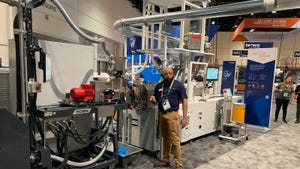Insert decorating process offers new design options
September 1, 2001
As more injection molders dabble in the art of inmold decorating (IMD), experts are developing new applications and processes that make this a more appealing tool. One of the latest developments comes from the insert side of the process and combines specialty inks with multilayer screen-printed parts.
Exploring this process is Lustre-Cal Nameplate Corp., a manufacturer of custom identification products for OEMs, Quashnick Tool Corp., a custom injection molder and moldmaker, and GE Structured Products. The three companies have perfected the use of UV inks in conjunction with a new insert mold decorating process.
|
Figure 1. The new IMD process combines heat-resistant UV inks with multilayer, second-surface screen printing to encapsulate text and graphics. |
The UV inks, according to the firms, provide better graphic registration than conventional IMD inks, do not crack during forming, and maintain finer details throughout the molding process.
The use of UV inks is new to the IMD process, in which multiple layers of graphics or text are screened onto the second surface of a sheet of transparent film. Second-surface printing allows overmolded transparent plastic (like a PC) to encapsulate the images and text, providing complete protection of the decorated insert. The layers can also be printed such that a different image or message can be viewed on each side of the film (Figure 1).
To create such two-sided labels, images and text slated to appear on the back side of the label are screened first and in reverse to be readable through the back of the label. To segregate the back and front of the label, the back-side graphics are covered with a flood layer of color (usually white), on which are screened the images to appear on the front of the label. This multilayer screen system eliminates the need for pad or other printing that might otherwise be used.
Historically, the challenge of such IMD systems has been molding over graphics without high-temperature resins damaging the ink. Lustre-Cal solved this when it developed a proprietary UV ink system used in the new IMD process that withstands high temperatures without smearing, washing out, or fading. The IMD process also allows parts to be screen printed with up to 22 colors.
Joe Hohenrieder, president of Lustre-Cal, says his company saw a need for UV inks for use with insert mold decorating in various industries such as electronics, appliance, telecommunications, and business equipment. These industries are always looking for a longer life label, he says.
Lustre-Cal teamed up with Terry Quashnick, president of Quashnick Tool, to develop a decorative IMD sample formed with GE's Lexan polycarbonate and built a single-cavity mold. R&D time for this IMD process, using a UV ink system, was about six months.
Contact information |
You May Also Like


